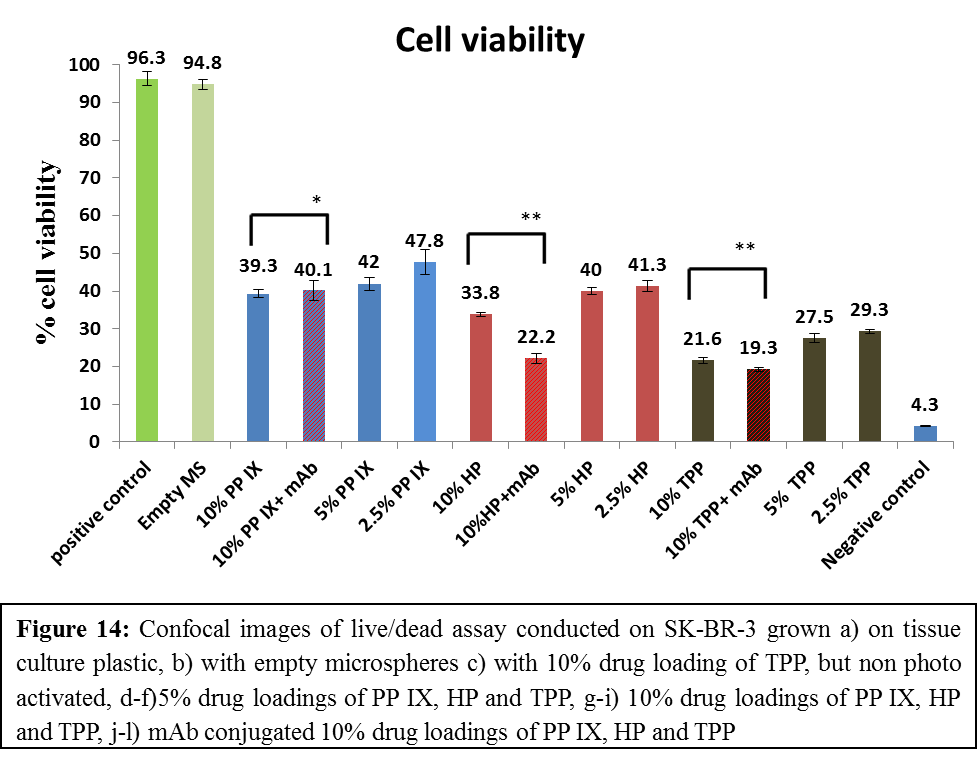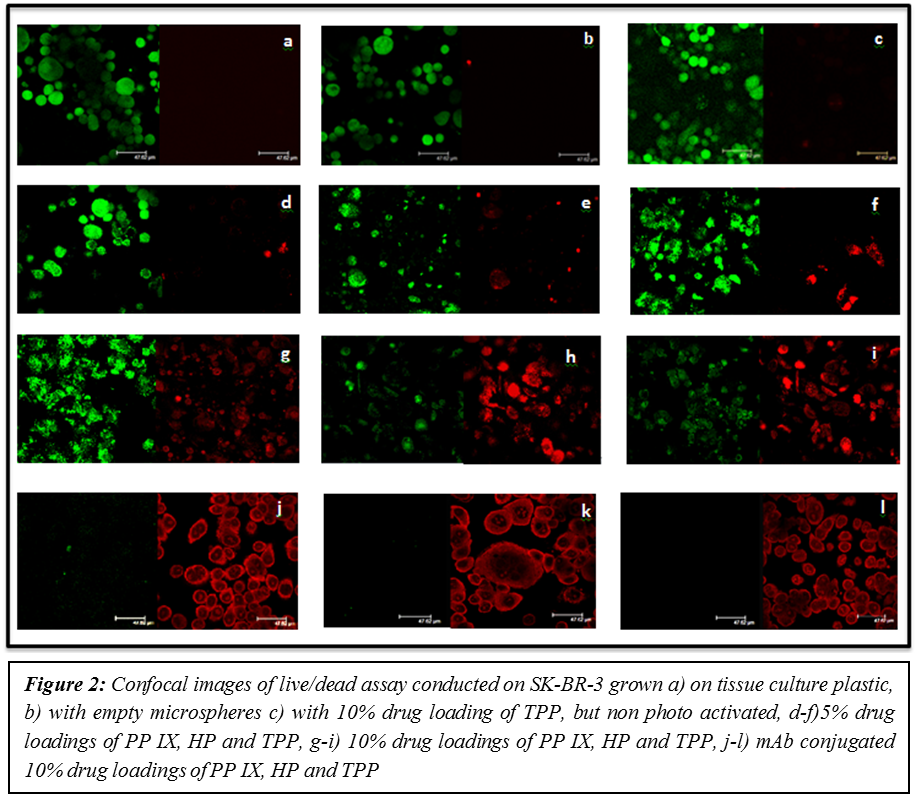Introduction: Photodynamic therapy (PDT) is an emerging alternative treatment modality to conventional cancer therapies. This involves the application of photosensitive drugs, systemically or tropically, followed by illumination with light of a suitable wavelength and dosage. A drug delivery system that is biodegradable, biocompatible, non-immunogenic and capable of encapsulation without altering the properties of the photosensitizer is desired. Biosynthetic polyhydroxyalkanoates (PHAs) have been extensively researched within the context of drug delivery [1]. This research investigates Poly(3-hydroxybutyrate) (P(3-HB)) microspheres as suitable target specific drug delivery systems of Porphyrin derivatives (protoporphyrin IX, tetraphenylporphyrin and hematoporphyrin ether) on mammary cancer cells. The microspheres have been coupled with anti-HER2 to enable target specificity for better incorporation by SK-BR-3 cells that overexpress HER-2 marker.
Materials and Methods: Production of photosensitizer encapsulated microsphere using P(3HB): P(3HB) synthesised using Kannan- Rehaceck media [2] was used for producing microspheres by solid-in-oil-in-water emulsion method. Varying process parameters were tested based on experiment design generated by design expert software; 2.5%w, 5%w and 10%w of drugs were then encapsulated in the P(3HB) microspheres.
Surface adsorption of the anti HER-2 antibody on microspheres: RFP coupled anti HER-2 antibody was expressed in Rosetta gami B(DE3) E. coli. These His-tagged proteins were purified using immobilised metal affinity chromatography and linked to the photosensitizer-encapsulated microspheres using surface adsorption. Protein adsorbed was quantified using Bradford’s assay.
Photoexcitaion and cytotoxicity tests: SK-BR-3 was cultured as specified by ATCC and incubated with the microspheres for 48 hours and subjected to white light exposure for 30 minutes. MTT assay was performed to assess cytotoxicity and live/dead staining was performed for confocal imaging.
Results and Discussion: Without photoexcitation, microspheres loaded and not loaded with porphyrin derivatives have similar cytotoxicity. Cytotoxic effect increased with increasing drug loading in each case and was found to be the highest in case of tetraphenylporphyrin (Figure 1).

anti HER-2 conjugation seemed to cause a further increase in cytotoxity in the case of hematoporphyrin ether and tetraphenylporphyrin, which was statistically significant (p<0.05). The absence of increased cytotoxicity in the case of protoporphyrin IX is attributed to loss of activity presented by processing conditions and is to be further investigated. The life span of singlet oxygen species generated is only ~3.5micro seconds and apoptotic factors generated by these have diffusion range of only 0.01-0.02micro meters [3]. Hence, successful localisation of the photosensitizer in the target is a key factor in determining the extent of photodynamic reaction caused. A further addition of a target specific antibody such as anti- HER2 recognizing the antigens presented by neoplastic transformation will result in a more efficient Photoimmunotargeting (PIT) [3]. The cells treated with these microspheres seemed to have much become enlarged (~60mm) as opposed to the others, suggesting a possible phagocytic mechanism (Figure 2).

Conclusion: Biosynthetic P(3-HB) is an excellent choice for synthesizing porous microspheres for photosensitizer delivery. Of the three porphyrin derivatives compared, tetraphenylporphyrin was found to be the most cytotoxic. As anti- HER2 conjugated microspheres were found to exhibit increased cytotoxicity, it can be concluded that these are promising candidates in Photoimmunotargeting.
I would like to thank Cavendish scholarship, University of Westminster.
References:
[1] Francis, Lydia and Meng, Decheng and Knowles, Jonathan C. and Keshavarz, Tajalli and Boccaccini, Aldo R. and Roy, Ipsita (2011) Controlled delivery of gentamicin using poly(3-hydroxybutyrate) microspheres. International Journal of Molecular Sciences, 12 (7). pp. 4294-4314. ISSN 1422-0067
[2] Valappil, Sabeel P. and Rai, R. and Bucke, Christopher and Roy, Ipsita (2008) Polyhydroxyalkanoate biosynthesis in Bacillus cereus SPV under varied limiting conditions and an insight into the biosynthetic genes involved. Journal of Applied Microbiology, 104 (6). pp. 1624-1635. ISSN 1364-5072
[3] • Solban, N., Rizvi, I., Hasan, T. (2006). Targeted photodynamic therapy. Lasers in Surgery and Medicine. 38 (5), 522-531.